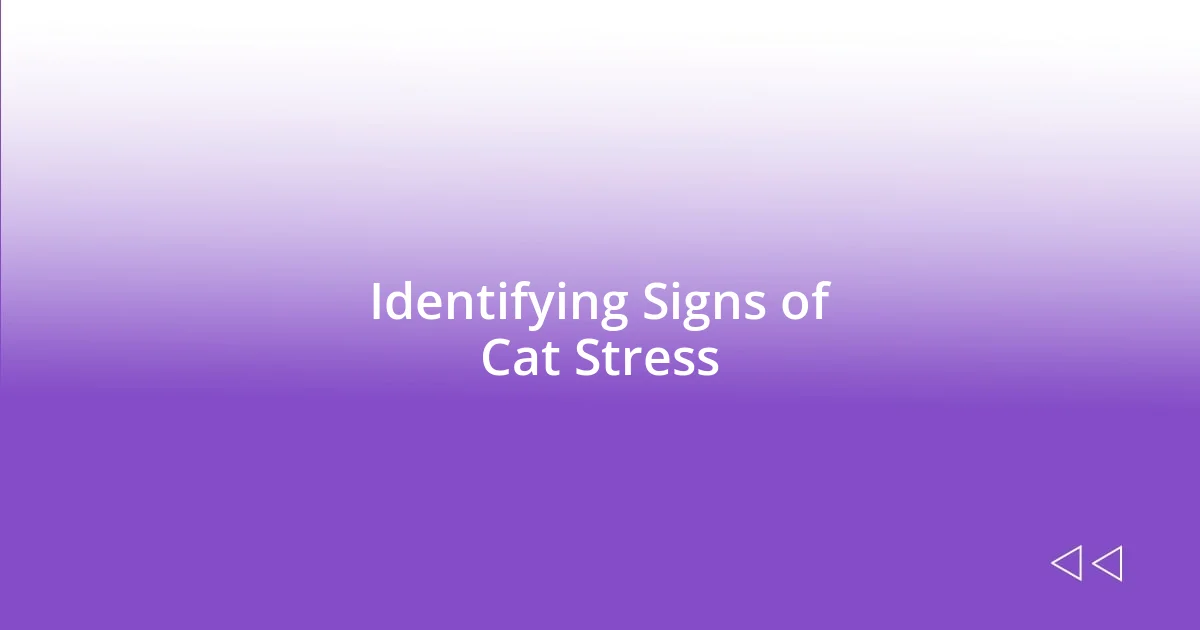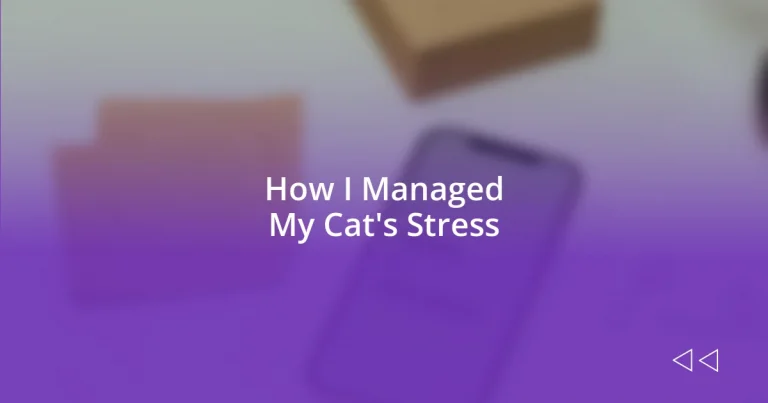Key takeaways:
- Cat stress can be triggered by environmental changes, unfamiliar individuals, and disrupted routines, highlighting the importance of a stable home environment.
- Recognizing signs of stress, such as over-grooming, behavioral changes, and litter box issues, is crucial for timely intervention and care.
- Creating a calm atmosphere and establishing routines, along with using enrichment activities, significantly improve cats’ well-being and reduce stress levels.

Understanding Cat Stress Factors
When it comes to understanding cat stress factors, I’ve often found that changes in their environment can have a huge impact. For instance, when I moved homes, my cats were visibly anxious. They spent hours hiding under furniture, reminding me how sensitive they can be to new spaces and smells.
Another common stress factor is the presence of unfamiliar people or pets. I remember a time when a friend brought their dog over. My cat, usually so confident, immediately climbed to the highest bookshelf. It made me think—how often do we underestimate how stressed our pets can feel in situations that seem normal to us?
Also, let’s consider routine disruptions. I once managed to disrupt my own cat’s feeding schedule by staying out later than usual. The next day, she was not only clingy but visibly agitated. It’s fascinating to observe such behaviors; they highlight just how much our pets thrive on predictability and how any sudden change can send them into a tailspin of stress.

Identifying Signs of Cat Stress
It’s crucial to recognize the signs of stress in our feline friends. One of the most telling signs I’ve noticed in my cats is when they start to over-groom or develop bald patches on their fur. I vividly recall one instance with my older cat, Jasper, who began obsessively licking his paws. It broke my heart to see him so distressed; it’s a clear indicator that something was off in his environment.
Another symptom can be changes in behavior, such as increased aggression or withdrawal. I remember a phase when my usually playful cat, Lily, suddenly became standoffish. She would hide for hours under the bed, avoiding interaction. It struck me that the stress of a recent house guest was affecting her deeply, showcasing just how sensitive they can be to external changes.
Additionally, paying attention to litter box habits can reveal stress levels. A few months ago, I noticed that Max had started to eliminate outside the box, which had never happened before. It turned out that he was feeling stressed by the new kitten we adopted. This experience taught me how vital it is to monitor not just their moods but also their habits for signs of distress.
| Signs of Cat Stress | Description |
|---|---|
| Over-grooming | Excessive licking can lead to bald patches and indicates anxiety. |
| Behavioral changes | Indicators like withdrawal or aggression reflect their discomfort. |
| Litter box issues | Eliminating outside the box suggests stress, often due to changes in the environment. |

Creating a Calm Environment
Creating a soothing atmosphere for my cats has made a remarkable difference in their overall happiness. I noticed that the noise levels in my home significantly impacted their stress levels. When I minimized loud sounds—like limiting TV time or avoiding shouting during games—my cats seemed to choose more peaceful spots to nap, often sprawled out under a quiet window rather than hiding in the back of a closet.
To enhance this calming environment, I started implementing a few simple changes:
- Soft Lighting: I replaced harsh overhead lights with warm lamps to create a serene ambiance.
- Dedicated Spaces: I set up cozy nooks with soft blankets that my cats could retreat to whenever they felt overwhelmed.
- Calm Music: Playing soft classical music or nature sounds helped in soothing their nerves, especially when they seemed restless.
- Plants: Adding cat-friendly plants not only beautified the space but also provided them with a more natural vibe.
Looking back, I remember how much Luna would thrive in these serene spots. The moment I acknowledged their need for a tranquil environment, I saw a shift—less hiding behavior and more playful interactions emerged, which filled my heart with joy.

Establishing a Routine for Cats
Establishing a routine for my cats has brought a sense of stability that they really appreciate. I remember when I started feeding them at the same times every day; it was like a lightbulb went off. No more frantic meowing during odd hours—just calm, predictable behavior. It’s fascinating how something so simple can make them feel secure.
I also noticed that incorporating playtime into our daily schedule helped reduce stress levels dramatically. Each evening, I would dedicate at least thirty minutes to interactive play sessions with a feather wand or laser pointer. Watching my cats chase and pounce, their worries seemed to lift with every leap. Have you ever noticed how engaging their natural instincts can instantly uplift their mood? I certainly did.
Additionally, a consistent bedtime created a cozy end to their day. Just like us, cats thrive on routine. Each night, I’d settle into my favorite chair with a book, and my cats would find their spots nearby. This shared downtime not only fostered bonding but also provided them with a calm environment to unwind. Establishing these routines gave my cats a comforting rhythm—they clearly understood that home was their safe haven.

Using Toys and Enrichment Activities
When I started exploring toys and enrichment activities, I was amazed at how much they transformed my cats’ mood. I discovered that interactive toys—like puzzle feeders—were not just fun, but they also provided mental stimulation. Watching Max play with a puzzle feeder filled with treats was a revelation; it kept him engaged for ages, and I loved seeing that spark of curiosity in his eyes. Have you ever seen your cat’s tail flick with excitement? It’s such a delightful sight!
Beyond just toys, I began to rotate their enrichment activities to keep things fresh and interesting. I’d introduce new scratching posts or climbing trees every few weeks. There was one instance where I brought home a cardboard box, and it became an instant fortress for the cats! They turned it into their playground, darting in and out like they were on a secret mission. Every time they played, I felt their stress dissipate, and it reminded me of how little things can bring so much joy.
It’s essential to tap into their instincts through play. I realized that my little Luna thrived when I incorporated chase-and-catch games with spring toys. Those moments when she would leap into the air, like she was part of an action movie, made my heart swell with happiness. Isn’t it incredible how providing them with the right toys can ignite their playful side? I could feel the positive energy flowing through our home, making it a happier place for all of us.

When to Seek Professional Help
Recognizing when my cats needed professional help was crucial for their well-being. One time, after a family move, I noticed that Cleo was unusually withdrawn and hiding in corners. Her normal playful antics turned into a lack of appetite, which made me worry. I’ve learned that drastic changes in behavior, like excessive hiding or sudden aggression, are often a sign that something deeper is going on. Have you ever felt that instinctive nudge to reach out for help, even if you hoped it wasn’t necessary? Trusting your gut can often lead you to the right decision.
There were moments, too, when I felt overwhelmed by their stress. I vividly remember a particularly rough week when both Luna and Max had issues with litter box avoidance, which was both puzzling and distressing. It dawned on me that sometimes, as much as we want to fix things ourselves, engaging a veterinarian or a feline behaviorist is the best course of action. Their expertise can make a world of difference in diagnosing issues that might be too subtle for us to notice. Seeking help is never a sign of failure; rather, it demonstrates a commitment to your pet’s happiness and health.
Lastly, if you ever find your cat showing signs of distress, like excess grooming or a complete personality shift, it could be time to consult a professional. I once took Max to a vet after he developed obsessive behaviors, and it turned out he had developed stress-related issues due to environmental changes. Now I understand that addressing these signs early is essential. Isn’t it the same for us? We often benefit from a little guidance to navigate our own anxieties, and our furry friends are no different.

Long-term Strategies for Reducing Stress
Creating a calm environment has been one of my key long-term strategies for reducing my cats’ stress. I realized that consistent routines served as a source of comfort for them. For instance, setting specific feeding times and incorporating gentle play sessions in the mornings helped Max and Luna feel secure. How often do we underestimate the power of routine in our lives? It brings a sense of stability, doesn’t it?
Another essential approach I’ve embraced is ensuring my home is a safe haven, free from loud noises or sudden disturbances. I recall a moment when I mistakenly played a loud movie while my cats were napping. Cleo jumped in surprise, and it took her quite a while to settle down again. That experience reminded me that small changes, like lowering the volume or creating cozy spaces away from hectic areas, can significantly reduce their anxiety levels.
Moreover, I’ve found that incorporating calming elements, like pheromone diffusers and soothing music, worked wonders over time. The first time I tried a diffuser, I was skeptical, but watching Luna snuggle down more comfortably in her favorite spot made me a believer. Have you ever noticed how certain scents or sounds just create a peace in your surroundings? It’s amazing what a little tranquility can do for both my emotional state and my cats’.












